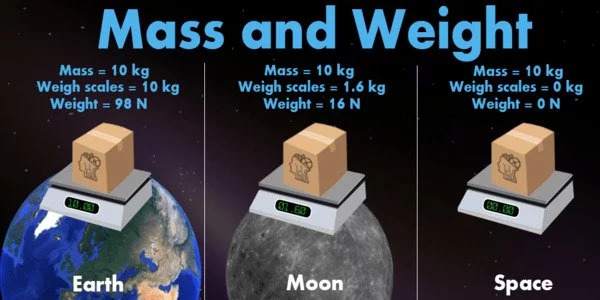Weight is the force of gravity acting on that mass and can vary depending on the strength of the gravitational field. Mass is a measure of the amount of matter in an object and is constant wherever the object is.
While mass quantifies the amount of matter in an object. The force of gravity on an object is measured by its weight. We come across these two terms frequently in our daily lives. When we talk about the weight of the body, we are actually talking about its mass, but these two concepts are not synonymous; in fact, they are distinct.
People use the terms interchangeably due to a lack of knowledge, which is incorrect because mass is the fundamental property of matter and weight is the force generated by gravitational pull on the object. So, carefully read the entire article, in which we’ve simplified the difference between mass and weight.

MASS
- Mass is the amount of matter contained in a body. It is defined as a measurement of inertia, and inertia is a property of a body that opposes change in its state. While mass is an object’s property that remains constant throughout the universe.
- The quantity of matter contained in a body is referred to as its mass. The term’mass’ refers to a physical quantity that indicates the amount of substance or matter present in something. It is the fundamental property of an object that determines its resistance to acceleration when force is applied to it. The mass of an object indicates the total number, type, and density of atoms contained within it.
- Mass is commonly measured by how much an object weighs; however, mass is not weight because it remains constant regardless of the object’s location. The kilogram (kg) is the internationally recognized unit of mass. However, other units of measurement exist, such as gram, milligram, tonnes, ounces, and pounds. It is represented by the letters M or m.
- Mass is a scalar expression with only magnitude. Mass is measured in kilograms (Kg), grams (g), and milligrams (mg). Pan balance, lever balance, triple-beam balance, and other types of balances are used to measure mass.
WEIGHT
- Weight is the force exerted on an object as a result of gravity’s pull. It is the measurement of force, where force is the product of mass and gravity’s acceleration. In contrast, weight is a property of a substance that varies depending on its location in the universe.
- Weight denotes the force exerted on an object as a result of gravity’s pull. Weight denotes the force generated by the earth’s gravitational pull, which attracts an object or body towards it. It is the product of mass (m) and gravity acceleration (g), often denoted by W. Because it has both magnitude and direction, it is a vector quantity, with the force acting vertically downwards. It is variable in nature, and that is why it increases or decreases with higher or lower gravity.
- Furthermore, the unit of weight is equal to the unit of force because the weight of a particle is the same as the force that pulls the particle towards the center of the earth. A physical body’s weight is directly related to its mass, in the sense that an increase in mass results in an increase in weight. Weight, in this sense, is ultimately a measure of mass.
- Weight, on the other hand, is a vector measure with both magnitude and direction. In contrast, the weight measurement unit is Newtons (N). The weight is measured using a spring balance or weighing machine.
There is a direct relationship between mass and weight, such that the greater something’s mass, the greater its weight. However, the main distinction between the two terms is that mass is constant, whereas weight varies depending on how far an object is from the center of the earth.















